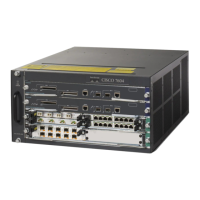Send document comments to nexus7k-docfeedback@cisco.com
6-6
Cisco Nexus 7000 Series NX-OS Interfaces Configuration Guide, Release 5.x
OL-23435-03
Chapter 6 Configuring Port Channels
Information About Port Channels
When the interface joins a port channel, some of its individual parameters are removed and replaced with
the values on the port channel as follows:
• Bandwidth
• Delay
• Extended Authentication Protocol over UDP
• VRF
• IP address (v4 and v6)
• MAC address
• Spanning Tree Protocol
• NAC
• Service policy
• Access control lists (ACLs)
Many interface parameters remain unaffected when the interface joins or leaves a port channel as
follows:
• Beacon
• Description
• CDP
• LACP port priority
• Debounce
• UDLD
• MDIX
• Rate mode
• Shutdown
• SNMP trap
If you configure subinterfaces for the port-channel interface and remove a member port from the port
channel, the configuration of the port-channel subinterface does not propagate to the member ports.
Note When you delete the port channel, the software sets all member interfaces as if they were removed from
the port channel.
See the “LACP Marker Responders” section on page 6-11 for information on port-channel modes.
Load Balancing Using Port Channels
The Cisco DC-OS software load balances traffic across all operational interfaces in a port channel by
hashing the addresses in the frame to a numerical value that selects one of the links in the channel. Port
channels provide load balancing by default. Port-channel load-balancing uses MAC addresses, IP
addresses, or Layer 4 port numbers to select the link. Port-channel load balancing uses either source or
destination addresses or ports, or both source and destination addresses or ports.

